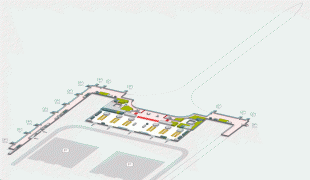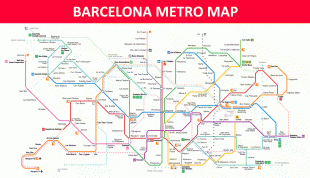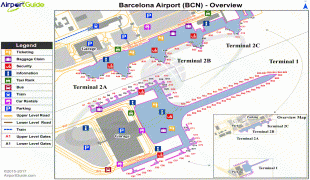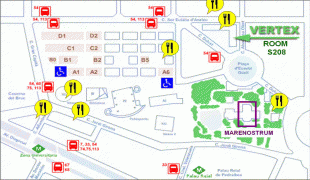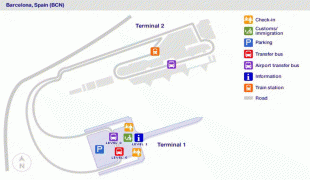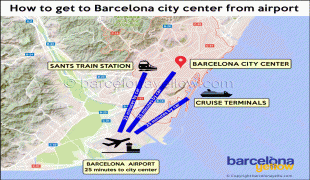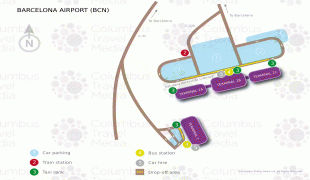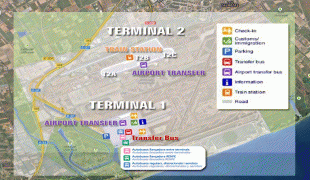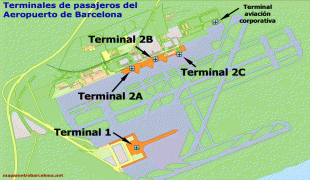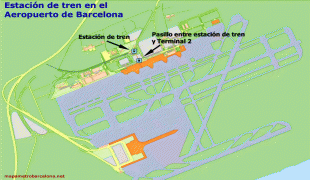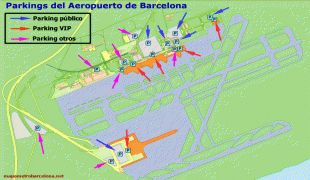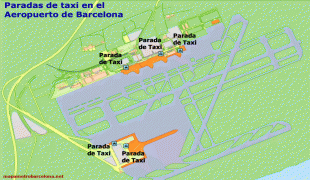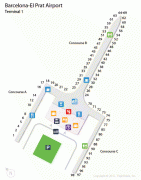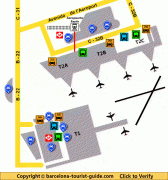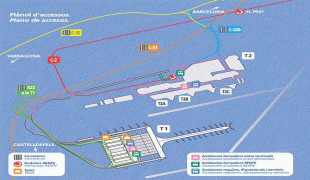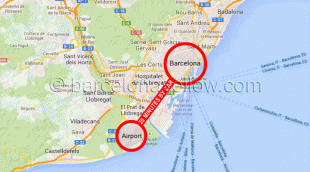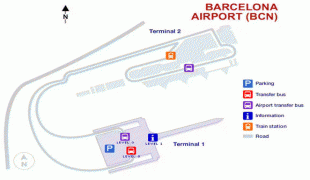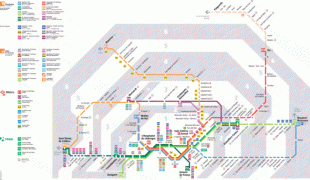Barcelona–El Prat Airport (Barcelona–El Prat Airport)
Josep Tarradellas Barcelona–El Prat Airport (Catalan: Aeroport Josep Tarradellas Barcelona-El Prat, Spanish: Aeropuerto Josep Tarradellas Barcelona-El Prat), and also known as El Prat Airport, is an international airport located 15 km southwest of the centre of Barcelona, lying in the municipalities of El Prat de Llobregat, Viladecans, and Sant Boi, in Catalonia, Spain.
It is the second largest and second busiest airport in Spain, and the sixth busiest in Europe. In 2019, Barcelona Airport handled a record 52,686,314 million passengers, up 5.0% from 2018. It is a hub for Level and Vueling, and a focus city for Air Europa, Iberia, EasyJet and Ryanair.
The Barcelona–Madrid air shuttle service, known as "Pont Aeri" (in Catalan) or "Puente Aéreo" (in Spanish), literally "Air Bridge", was the world's busiest route until 2008, with the highest number of flight operations (971 per week) in 2007. The schedule has been reduced since February 2008, when a Madrid–Barcelona high-speed rail line was opened, covering the distance in 2 hours 30 minutes, and quickly became popular.
Barcelona's first airfield, located at El Remolar, began operations in 1916. However, it did not have good expansion prospects, so a new airport at El Prat opened in 1918. The first plane was a Latécoère Salmson 300 which arrived from Toulouse with final destination Casablanca. The airport was used as headquarters of the Aeroclub of Catalonia and the base for the Spanish Navy's Zeppelin fleet. Scheduled commercial service began in 1927 with an Iberia service to Madrid Cuatro Vientos Airport. This was Iberia's first route. During the time of the Second Spanish Republic El Prat was one of the bases of LAPE (Líneas Aéreas Postales Españolas).
In 1948, a runway was built (now called runway 07-25); in the same year the first overseas service was operated by Pan American World Airways to New York City, using a Lockheed Constellation. Between 1948 and 1952, a second runway was constructed (runway 16–34), perpendicular to the previous, also taxiways were constructed and a terminal to accommodate passengers. In 1963, the airport reached one million passengers a year. A new control tower was built in 1965. In 1968, a new terminal was opened, which still exists and is in use as what is now Terminal 2B.
On 3 August 1970, Pan American World Airways inaugurated regular service between Barcelona, Lisbon and New York, operated by a Boeing 747. On 4 November of the same year, Iberia began the "Air-shuttle" service between Barcelona and Madrid–Barajas. A few years later, in 1976, a terminal was built specifically for Iberia's air-shuttle service and a terminal exclusively for cargo, an annexed mail service and an aircraft ramp for air cargo. In 1977, the airport handled over 5 million passengers annually.
From the late seventies to the early nineties, the airport was stalled in traffic and investments until the 1992 Summer Olympics held in Barcelona. El Prat underwent a major development consisting of the modernization and expansion of the existing terminal, which became known as Terminal B, and the construction of two further terminals flanking that, known as Terminals A and C respectively.
The new Terminal 1 was inaugurated on 16 June 2009, covering 545000 m². 70% of today's flights operate from Terminal 1. The old Terminals A, B and C are now known as Terminals 2A, 2B and 2C.
Due to the strong drop in air traffic after 1999 and the crisis in the aviation sector in 2001 many charter operations from Girona and Reus were diverted to El Prat, which helped the airport to survive the crisis.
On 1 February 2014, Barcelona–El Prat was the first Spanish airport to receive a daily flight with the Airbus A380-800, on the Emirates route to Dubai International Airport. Emirates also offers a second daily flight, also operated by the A380-800.
It is the second largest and second busiest airport in Spain, and the sixth busiest in Europe. In 2019, Barcelona Airport handled a record 52,686,314 million passengers, up 5.0% from 2018. It is a hub for Level and Vueling, and a focus city for Air Europa, Iberia, EasyJet and Ryanair.
The Barcelona–Madrid air shuttle service, known as "Pont Aeri" (in Catalan) or "Puente Aéreo" (in Spanish), literally "Air Bridge", was the world's busiest route until 2008, with the highest number of flight operations (971 per week) in 2007. The schedule has been reduced since February 2008, when a Madrid–Barcelona high-speed rail line was opened, covering the distance in 2 hours 30 minutes, and quickly became popular.
Barcelona's first airfield, located at El Remolar, began operations in 1916. However, it did not have good expansion prospects, so a new airport at El Prat opened in 1918. The first plane was a Latécoère Salmson 300 which arrived from Toulouse with final destination Casablanca. The airport was used as headquarters of the Aeroclub of Catalonia and the base for the Spanish Navy's Zeppelin fleet. Scheduled commercial service began in 1927 with an Iberia service to Madrid Cuatro Vientos Airport. This was Iberia's first route. During the time of the Second Spanish Republic El Prat was one of the bases of LAPE (Líneas Aéreas Postales Españolas).
In 1948, a runway was built (now called runway 07-25); in the same year the first overseas service was operated by Pan American World Airways to New York City, using a Lockheed Constellation. Between 1948 and 1952, a second runway was constructed (runway 16–34), perpendicular to the previous, also taxiways were constructed and a terminal to accommodate passengers. In 1963, the airport reached one million passengers a year. A new control tower was built in 1965. In 1968, a new terminal was opened, which still exists and is in use as what is now Terminal 2B.
On 3 August 1970, Pan American World Airways inaugurated regular service between Barcelona, Lisbon and New York, operated by a Boeing 747. On 4 November of the same year, Iberia began the "Air-shuttle" service between Barcelona and Madrid–Barajas. A few years later, in 1976, a terminal was built specifically for Iberia's air-shuttle service and a terminal exclusively for cargo, an annexed mail service and an aircraft ramp for air cargo. In 1977, the airport handled over 5 million passengers annually.
From the late seventies to the early nineties, the airport was stalled in traffic and investments until the 1992 Summer Olympics held in Barcelona. El Prat underwent a major development consisting of the modernization and expansion of the existing terminal, which became known as Terminal B, and the construction of two further terminals flanking that, known as Terminals A and C respectively.
The new Terminal 1 was inaugurated on 16 June 2009, covering 545000 m². 70% of today's flights operate from Terminal 1. The old Terminals A, B and C are now known as Terminals 2A, 2B and 2C.
Due to the strong drop in air traffic after 1999 and the crisis in the aviation sector in 2001 many charter operations from Girona and Reus were diverted to El Prat, which helped the airport to survive the crisis.
On 1 February 2014, Barcelona–El Prat was the first Spanish airport to receive a daily flight with the Airbus A380-800, on the Emirates route to Dubai International Airport. Emirates also offers a second daily flight, also operated by the A380-800.
| IATA Code | BCN | ICAO Code | LEBL | FAA Code | |
|---|---|---|---|---|---|
| Telephone | +34 902 404 704 | Fax | |||
| Home page | Hyperlink |
Map - Barcelona–El Prat Airport (Barcelona–El Prat Airport)
Map
Country - Spain
 |
 |
| Flag of Spain | |
Anatomically modern humans first arrived in the Iberian Peninsula around 42,000 years ago. The ancient Iberian and Celtic tribes, along with other pre-Roman peoples, dwelled the territory maintaining contacts with foreign Mediterranean cultures. The Roman conquest and colonization of the peninsula (Hispania) ensued, bringing the Romanization of the population. Receding of Western Roman imperial authority ushered in the migration of different non-Roman peoples from Central and Northern Europe with the Visigoths as the dominant power in the peninsula by the fifth century. In the early eighth century, most of the peninsula was conquered by the Umayyad Caliphate, and during early Islamic rule, Al-Andalus became a dominant peninsular power centered in Córdoba. Several Christian kingdoms emerged in Northern Iberia, chief among them León, Castile, Aragon, Portugal, and Navarre made an intermittent southward military expansion, known as Reconquista, repelling the Islamic rule in Iberia, which culminated with the Christian seizure of the Emirate of Granada in 1492. Jews and Muslims were forced to choose between conversion to Catholicism or expulsion, and eventually the converts were expelled through different royal decrees.
Currency / Language
| ISO | Currency | Symbol | Significant figures |
|---|---|---|---|
| EUR | Euro | € | 2 |
| ISO | Language |
|---|---|
| EU | Basque language |
| CA | Catalan language |
| GL | Galician language |
| OC | Occitan language |
| ES | Spanish language |






